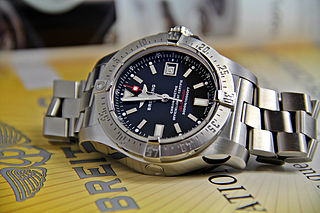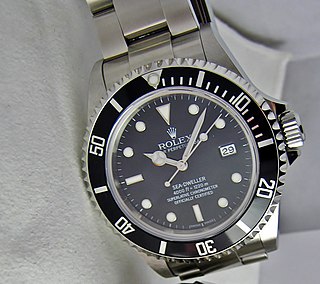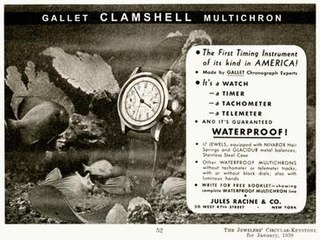
A watch is a portable timepiece intended to be carried or worn by a person. It is designed to keep a consistent movement despite the motions caused by the person's activities. A wristwatch is designed to be worn around the wrist, attached by a watch strap or other type of bracelet, including metal bands, leather straps, or any other kind of bracelet. A pocket watch is designed for a person to carry in a pocket, often attached to a chain.

Rolex SA is a Swiss watch brand and manufacturer based in Geneva, Switzerland. Founded in 1905 as Wilsdorf and Davis by German businessman Hans Wilsdorf and his brother-in-law Alfred Davis in London, the company registered Rolex as the brand name of its watches in 1908 and became Rolex Watch Co. Ltd. in 1915. After World War I, the company moved its base of operations to Geneva because of the unfavorable economy in the United Kingdom. In 1920, Hans Wilsdorf registered Montres Rolex SA in Geneva as the new company name ; it later became Rolex SA. Since 1960, the company has been owned by the Hans Wilsdorf Foundation, a private family trust.

IWC International Watch Co. AG, founded International Watch Company, better known as IWC Schaffhausen, is a Swiss luxury watch manufacturer located in Schaffhausen, Switzerland. Originally founded in Switzerland by American watchmaker Florentine Ariosto Jones in 1868, the company was transferred to the Rauschenbach family in 1880 after bankruptcy and has been a subsidiary of the Swiss Richemont Group since 2000.

A pocket watch is a watch that is made to be carried in a pocket, as opposed to a wristwatch, which is strapped to the wrist.

Water Resistant is a common mark stamped on the back of wrist watches to indicate how well a watch is sealed against the ingress of water. It is usually accompanied by an indication of the static test pressure that a sample of newly manufactured watches were exposed to in a leakage test. The test pressure can be indicated either directly in units of pressure such as bar, atmospheres, or as an equivalent water depth in metres.

The history of watches began in 16th-century Europe, where watches evolved from portable spring-driven clocks, which first appeared in the 15th century.

The Rolex Oyster Perpetual Submariner is a line of sports watches designed for diving and manufactured by Rolex, resistant to water and corrosion. The first Submariner was introduced to the public in 1954 at the Basel Watch Fair. It was the first watch to be waterproof up to 100 metres (330 ft). The Rolex Submariner is considered "a classic among wristwatches", manufactured by one of the most widely recognized luxury brands in the world. Due to its huge popularity, there are many homage watches by well-established watchmakers, as well as illegal counterfeits. The Rolex Submariner is part of Rolex's Professional line.
Anti-magnetic (non-magnetic) watches are those that are able to run with minimal deviation when exposed to a certain level of magnetic field. The International Organization for Standardization issued a standard for magnetic-resistant watches, which many countries have adopted.

A diving watch, also commonly referred to as a diver's or dive watch, is a watch designed for underwater diving that features, as a minimum, a water resistance greater than 1.1 MPa (11 atm), the equivalent of 100 m (330 ft). The typical diver's watch will have a water resistance of around 200 to 300 m, though modern technology allows the creation of diving watches that can go much deeper. A true contemporary diver's watch is in accordance with the ISO 6425 standard, which defines test standards and features for watches suitable for diving with underwater breathing apparatus in depths of 100 m (330 ft) or more. Watches conforming to ISO 6425 are marked with the word DIVER'S to distinguish ISO 6425 conformant diving watches from watches that might not be suitable for actual scuba diving.

The Rolex Oyster Perpetual Date Sea-Dweller is a line of diver's watches manufactured by Rolex, with an underwater diving depth rating of 1,220 meters and up to 3,900 metres (12,800 ft) for the Sea-Dweller Deepsea variant. In 2022 the dimensionally large Deepsea Challenge Sea-Dweller variant with an official depth rating of 11,000 metres (36,090 ft) was added to the line. The Rolex Sea-Dweller is part of Rolex's Professional line.
The J12 is a line of Swiss made luxury watches introduced in 1999 by French haute couture house Chanel. The J12 was launched in 1999 and is considered as a unisex watch. The watch was designed by the artistic director of the house, Jacques Hélleu, who found inspiration in the two worlds he loved most: automobiles and sailing. Chanel uses highly scratch-resistant ceramic for the watch's case and bracelet. Other materials are used as well, such as titanium and for one of the house's limited edition watches, sapphires were used to create the entirety of the bracelet and case.
Shock resistant is a common mark stamped on the back of wrist watches to indicate how well a watch copes with mechanical shocks. In a mechanical watch, it indicates that the delicate pivots that hold the balance wheel are mounted in a spring suspension system intended to protect them from damage if the watch is dropped. One of the earliest and most widely used was the Incabloc system, invented in 1934. Before the widespread adoption of shock-resistant balance pivots in the 1950s, broken balance wheel staffs were a common cause of watch repairs.

Gallet (ˈgæl.eɪ) is a historic Swiss manufacturer of high-end timepieces for professional, military, sports, racing, and aviation use. Gallet is the world's oldest clock making house with history dating back to Humbertus Gallet, a clock maker who became a citizen of Geneva in 1466. It is one of the oldest continuously operating companies in the World. The Gallet & Cie name was officially registered by Julien Gallet (1806–1849) in 1826, who moved the family business from Geneva to La Chaux-de-Fonds, Switzerland. Prior to this date, operations commenced under the name of each of the Gallet family patriarchs.

The trench watch (wristlet) is a type of watch that came into use by the military during World War I, as pocket watches were not practical in combat. It was a transitional design between pocket watches and wristwatches, incorporating features of both.
The Flying Officer chronograph wristwatch (1939–present), designed and manufactured in La Chaux-de-Fonds, Switzerland by Gallet & Co., was commissioned by Senator Harry S. Truman from Missouri in 1939 for pilots and navigators of the United States Army Air Forces.
The Bozeman Watch Company of Bozeman, Montana, was an American company that designed and engineered its own timepieces and had its mechanical components certified by the Contrôle officiel suisse des Chronomètres (COSC) certified timepieces. The Bozeman Watch Company went out of business on May 9, 2015.

The Clamshell, manufactured between 1936 and 1951 by the Gallet Watch Company of Switzerland, is the world's first water resistant wrist chronograph.
MIL-W-46374 is a specification first published on October 30, 1964, for US military watches. The 46374 was specified as an accurate, disposable watch. In its span, it encompassed metal and plastic cased watches with both mechanical and quartz movements. The 46374 replaced the MIL-W-3818, reducing cost and inheriting the dial from the MIL-W-3818B. These were lower quality watches than the 15 jewel movements, the transition started as US involvement in Vietnam ramped up.
US military watches are watches that are issued to US military personnel.

Montres Tudor SA, or simply Tudor, is a Swiss watchmaker based in Geneva, Switzerland. Registered in 1926 by Hans Wilsdorf, founder of Rolex, the brand remains a sister company to Rolex; both companies are owned by the Hans Wilsdorf Foundation. Tudor was initially known for watches produced for the military and professional divers. From the 1960s to 1980s, several navies issued Tudor Submariners to their divers, including the US Navy SEALs and the French Marine Nationale.













